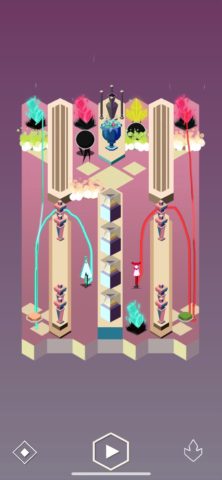Developer: Diceroll Studios
Price: $3/£3
Size: 386 MB
Version: 1.015
Platform: iPhone & iPad
Huey and Satura, the co-stars of Umiro, awake in a strange fantasy land with only fleeting memories of the world they originally came from. It’s up to you to guide them through a series of abstract levels and towards some kind of recollection.
This is as simple a task as sketching out a path for each of them, which they will embark upon as soon as you hit the play button at the bottom of the screen.

Coordination is the key
Of course, it’s not going to be as easy as all that. There are plenty of obstacles standing in your way, including hazardous black orbs that patrol each stage. There are colored barriers that must be deactivated by flipping a switch, while each level has a yellow gem that must be collected en route to the exit – not to mention multiple route markers that need to be hit.
The core challenge in this clever puzzler comes from the fact that the levels are asymmetrical, and the paths for both characters vary greatly in length. Despite this, the pre-planned path-drawing system means that both characters must move simultaneously.

As you sketch, you fill in color
You’ll soon realize that there are tricks to be played with the path-drawing system. Is Satura arriving to a certain point too soon and getting snagged by a black orb? Then press and hold on her route just prior to the collision and squiggle a few tight circles to delay her progress by a second or two.
As this suggests, there’s a fair amount of trial and error involved in cracking Umiro’s trickier levels. It’s rare that you’ll hit upon a winning solution straight away in these scenarios, and that’s largely because the core mechanics aren’t quite tight or predictable enough to do so.

The two characters will chat
Still, the game is pleasant to look at, if hardly striking in its originality after two rounds of Monument Valley (and numerous imitators). Umiro is bold in its use of color, while the levels contain a mixture of simple geometric shapes and fine details.
The way Umiro’s story is relayed can seem a little confusing at first. In between levels (of which there are 40, plus some special stages), Huey and Satura’s tale is told through static, wordless pictures, which require a little deciphering despite their inherent simplicity. Meanwhile, the two leads will exchange a few words in the levels proper.

The story is told with pretty static drawings
It doesn’t matter all that much through. Umiro’s strength is in its neat path-finding puzzles, and in finding clever ways to game its clockwork levels. It doesn’t always execute this with perfect clarity, but it’s consistently engaging.

